In the dynamic realm of artificial intelligence (AI), the precision and accuracy of data play a pivotal role in determining the success of AI applications. As industries increasingly lean towards data annotation outsourcing to refine their datasets, one technique stands out for its granularity and versatility: keypoint annotation. This method, while not as commonly discussed as other annotation techniques, has profound implications across sectors like healthcare, retail, and beyond. In this article, we’ll delve into the intricacies of keypoint annotation, its applications, and its transformative role in AI.
What is Keypoint Annotation?
Keypoint annotation, at its core, involves marking specific points, or “keypoints”, on an image or video to represent certain features or parts of an object. These keypoints serve as reference points for algorithms, helping them recognize and understand the structure or movement of the object in question. For instance, in human pose estimation, keypoints might be placed on joints to understand human postures. The precision of keypoint annotation ensures that AI models can discern intricate details, making it invaluable for tasks that require a high level of detail.
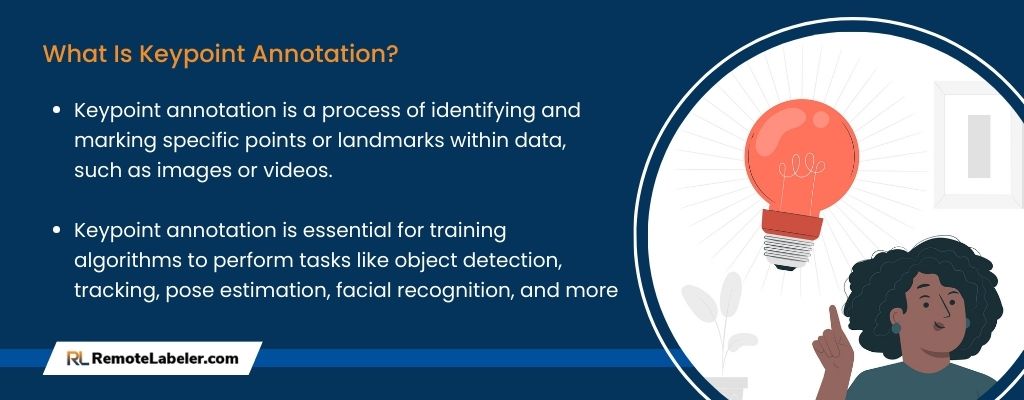
Types of Data Annotated with Keypoints:
Keypoint annotation isn’t limited to a single type of data. Its adaptability allows it to be applied across various formats, each offering unique insights and applications. By marking specific points on these data types, AI models can be trained to recognize patterns, understand context, and make informed decisions based on the keypoints.
Images
Images, being the cornerstone of many AI applications, benefit immensely from keypoint annotation. Whether it’s identifying facial features in a portrait, mapping out the structure of a complex machine part, or highlighting areas of interest in aerial photographs, keypoint annotation on images helps in identifying and understanding static features. This is particularly useful in tasks that require a detailed understanding of object structures or relationships between different parts of an image.
Video
Video keypoint annotation takes the process a notch higher by tracking the movement of keypoints across frames. This dynamic annotation is crucial for applications like motion analysis, sports performance assessment, or tracking the progression of certain features over time. For instance, in wildlife monitoring, the movement patterns of animals can be studied by annotating keypoints on their joints or specific body parts.
3D Models
With the rise of augmented reality (AR) and virtual reality (VR), 3D models have become integral to many tech applications. Keypoint annotation on 3D models can help in understanding the depth, orientation, and spatial relationships of different parts of the model. This is especially useful in industries like gaming, where character movements need to be realistic, or in architecture, where understanding the spatial dynamics of a structure is crucial.
Time-Series Data
While not visual in the traditional sense, time-series data, which captures information at successive points in time, can also benefit from keypoint annotation. By marking keypoints at significant events or changes in the data, algorithms can be trained to recognize patterns, predict future events, or detect anomalies.
By understanding the types of data that can be annotated with keypoints, industries can better harness the potential of this technique, ensuring that their AI models are trained with precision and depth.
The Role of Keypoint Annotation in AI
Keypoint annotation acts as a bridge, translating the complexities of the visual world into data points that AI algorithms can understand and learn from. This form of annotation, whether it’s coco keypoint annotation or cvat keypoint annotation, provides a structured way for machines to recognize patterns, understand context, and make informed decisions.
In the vast landscape of AI, keypoint annotation offers:
- Precision & Detail: By focusing on specific points, AI models can discern minute details, ensuring accurate recognition and interpretation.
- Versatility: Keypoint annotation is adaptable, making it suitable for a range of applications, from healthcare diagnostics to retail product recognition.
- Efficiency: With precise keypoints, AI models often require less training time as they have clear, defined reference points to learn from.
- Enhanced Machine Learning: The granularity of keypoint data ensures that machine learning models are fed with quality data, leading to better, more accurate outcomes.
As industries continue to harness the power of AI, the importance of techniques like keypoint annotation becomes increasingly evident. It’s not just about feeding data to machines; it’s about ensuring that this data is precise, relevant, and structured, paving the way for AI innovations that can truly transform industries.
Keypoint Annotation in Healthcare
The healthcare sector, with its ever-evolving challenges and demands, stands to gain immensely from the precision of keypoint annotation. Especially in the realm of remote healthcare services, where accurate diagnosis and treatment recommendations are paramount, keypoint annotation can play a transformative role.
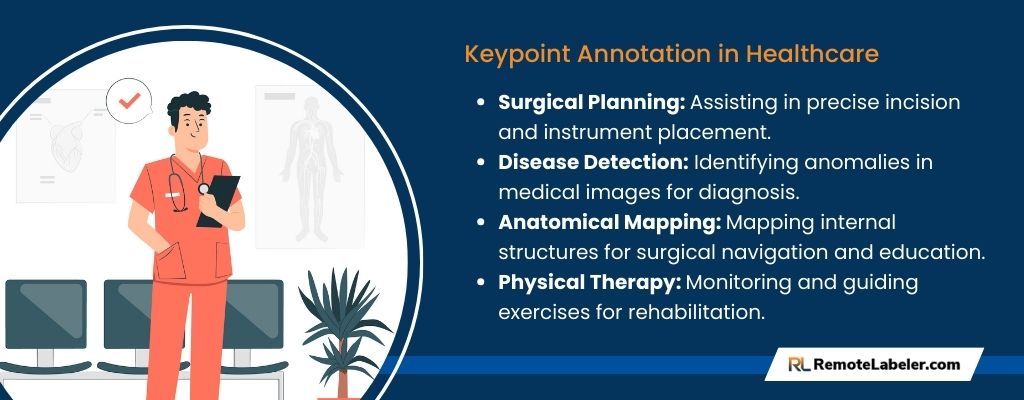
Telemedicine and Remote Diagnosis
With the rise of telemedicine, doctors often rely on images and videos sent by patients to diagnose conditions. Keypoint annotation can highlight specific areas of concern in these images, ensuring that doctors don’t miss subtle signs or symptoms. For instance, in dermatology, keypoints can be used to track the growth or change in skin lesions over time.
Posture and Movement Analysis
For physiotherapists and orthopedic specialists, understanding a patient’s posture and movement is crucial. Keypoint annotation on videos can help in analyzing joint movements, identifying irregularities, and recommending corrective exercises or treatments.
Keypoint Annotation in Retail
In the bustling world of retail, where customer experience and product presentation are king, keypoint annotation offers a myriad of applications to enhance services.
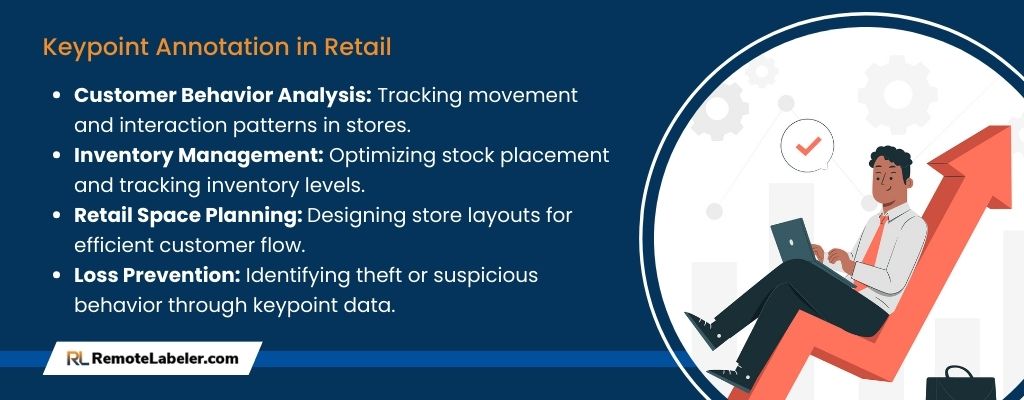
Virtual Try-Ons
With the surge in online shopping, virtual try-ons have become popular. Keypoint annotation can be used to map the contours and keypoints of a user’s body, allowing for accurate virtual fitting of clothes, shoes, or accessories.
Product Recognition and Display
In virtual store setups, keypoint labeling can help in recognizing products in real-time, ensuring that customers are presented with accurate product information, reviews, or even augmented reality displays of the product in use.
Other Industries Benefiting from Keypoint Annotation
Beyond healthcare and retail, keypoint annotation is making waves in a myriad of sectors, each with its unique challenges and requirements. Its versatility and precision are unlocking new potentials, transforming operations, and enhancing user experiences across diverse industries.
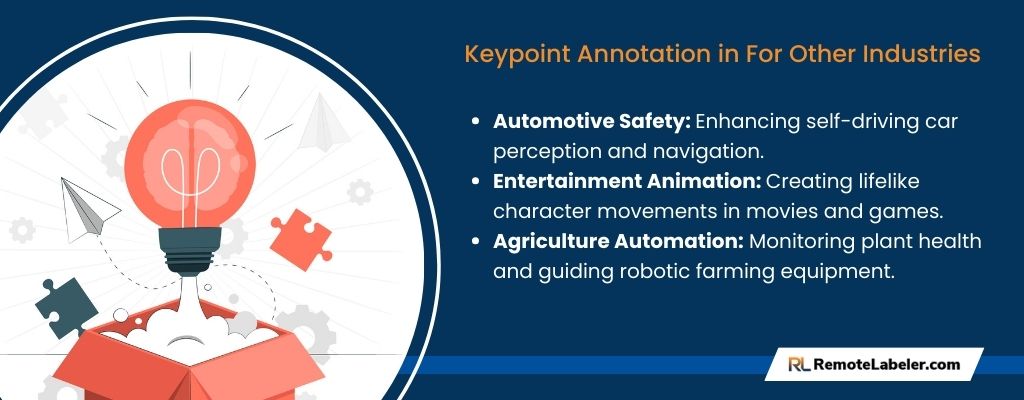
Automotive
In the automotive industry, keypoint annotation can assist in advanced driver-assistance systems (ADAS). By annotating keypoints on vehicles, pedestrians, or obstacles, these systems can make real-time decisions, enhancing road safety.
Entertainment
For animation and gaming, keypoint annotation, especially in the coco keypoint annotation format, can be used to map the movements of real actors, translating them into animated characters or avatars, ensuring realistic motion and interactions.
Agriculture
In agriculture, drones often capture aerial images of crops. Keypoint annotation can identify signs of pest infestations, crop diseases, or areas that need irrigation, enabling farmers to take timely action.
Remote Labeler’s Expertise in Keypoint Annotation
Remote Labeler, with its rich experience in data annotation, has carved a niche in the realm of keypoint annotation. Our expertise spans across industries, from healthcare to retail, ensuring that our clients receive annotations of the highest quality. Benefits of partnering with us include:
- Precision: Our team is trained in the coco keypoint annotation format, ensuring accurate and detailed annotations.
- Versatility: From roof annotation to keypoint labeling, our services cater to a wide range of requirements.
- Scalability: Whether it’s a small project or a large-scale operation, our infrastructure and team are equipped to handle it.
- Data Security: We prioritize the confidentiality and security of your data, ensuring it’s protected at all times.
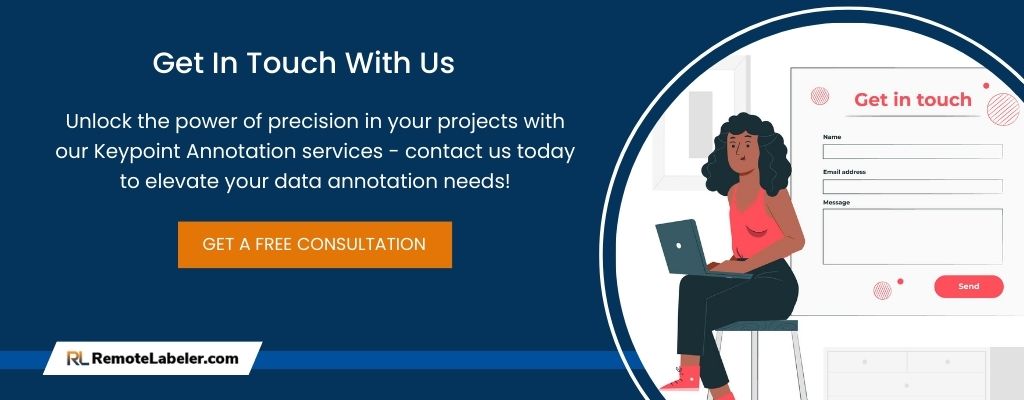
Conclusion
Keypoint annotation, with its granularity and precision, is revolutionizing industries, from healthcare to entertainment. Its ability to provide detailed insights ensures that AI models across sectors are more accurate, efficient, and effective. As the world continues to embrace AI, the role of keypoint annotation, and experts like Remote Labeler, will only become more pivotal.
Ready to harness the power of keypoint annotation for your business? Contact us and get precise data annotation tailored to your needs.
- Emerging Trends and Future Outlook: The Data Labeling Industry in 2024-2030 - December 8, 2023
- Landmark Annotation: Key Points - November 6, 2023
- All You Should Know About Bounding Box Annotation - November 5, 2023